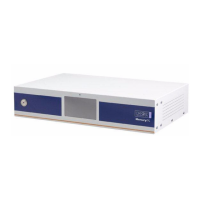Handbook
November 2011 / 59-UMC0071 / Issue 01
Mercury iTC
Page 131
AUXILIARY I/O DAUGHTER BOARD
Original Instructions
15 AUXILIARY I/O DAUGHTER BOARD
The auxiliary I/O board can be fitted in any expansion slot in the iTC.
15.1 Description of the auxiliary I/O board
15.1.1 Auxiliary I/O board functions
The optional auxiliary board performs the following functions:
It provides a stepper-motor drive and sense input. This can be used to drive an
automatic gas-flow control accessory (AutoGFS).
It provides an override input to disable the heater output. This allows an external
over-temperature switch to disable the heater.
It provides control signals for the high-power output unit OP3KW MkII (if fitted).
The auxiliary port connections are made via a 15-way D-socket on the rear panel.
The outputs are open-collector transistors, and each can sink up to 500 mA from a
maximum supply voltage of +25 VDC. If the load is inductive, it is recommended that a
diode is connected across the load to absorb the stored energy.
Low-power loads can be driven directly from pin 15, which is connected to the
unregulated 11 V line via a diode and a fuse. Pin 15 can source a maximum current of
500 mA.
The input lines on the auxiliary port can either be driven by TTL levels, or by contact
closures switching to +5 VDC. A 100 kOhm pull-down resistor (to 0 V) is fitted to each
input.
The AutoGFS sense input must be linked to +5 VDC when an AutoGFS unit is
connected.
If a temperature-switch is fitted, it must be connected so that an over-temperature
condition pulls the input above +2.5 VDC. The internal 100 kOhm resistor may be
shunted by an external resistor, if required to match the input to a sensor characteristic.
15.1.2 Gas-flow control using a motorised needle-valve
The auxiliary I/O board can control a motorised needle-valve, regulating the flow of
cryogenic fluid in a cryostat. There are two possible configurations:
Automatic needle valve
The needle-valve is fitted to the main cryostat and controls the flow between the
cryogen reservoir and a variable-temperature insert.
Automatic gas flow syphon
The needle valve is fitted in an automated gas-flow syphon, linking the cryostat to a
separate cryogen storage-vessel.
The flow dynamics of these two arrangements are different.
See Section 12.3 for a description of gas-flow control.

